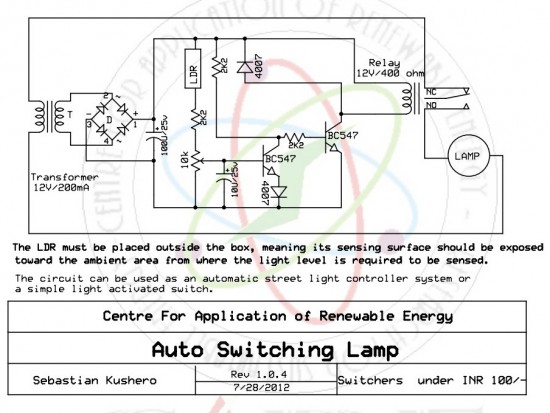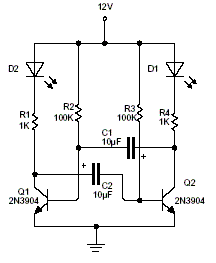
Super bright LED night light

The circuit diagram illustrates a super bright LED night lamp that operates from the mains supply. A bridge rectifier (D1) is employed to convert the AC mains voltage into DC. The combination of capacitor (C1) and resistor (R1) forms a current limiting circuit. Ten ultra-bright white LEDs are connected in series to generate the desired illumination. An n-channel FET (Q1, ZVN 2106) is utilized to automatically turn off the lamp when it reaches full brightness. The photoresistor's resistance is calibrated to 100K ohms at full brightness; any resistance below this threshold will immediately deactivate the LEDs. A Zener diode (D2) is incorporated to restrict the peak voltage across C1 during the switching of the LEDs.
The circuit operates by first rectifying the AC voltage from the mains supply through the bridge rectifier D1, which converts it to a pulsating DC voltage. The capacitor C1 smooths this output, providing a steady voltage suitable for the LEDs and other components. The resistor R1 is critical in limiting the current flowing through the LEDs to prevent damage and ensure optimal brightness.
The series connection of ten ultra-bright white LEDs allows for a significant increase in light output, making the lamp suitable for use as a night lamp. The n-channel FET Q1 (ZVN 2106) serves as a switch that automatically turns off the LED array when the ambient light level reaches a certain threshold, ensuring energy efficiency and extending the lifespan of the components. The photoresistor acts as a light sensor, with its resistance value being 100K ohms at full brightness. If the ambient light increases, causing the resistance to drop below this value, the FET will switch off the LED circuit, effectively turning off the lamp.
Finally, the Zener diode D2 plays a protective role by clamping the voltage across the capacitor C1, preventing over-voltage conditions that could arise during the switching process of the LEDs. This design ensures that the circuit operates safely and reliably, making it an effective solution for a super bright LED night lamp.Here is the circuit diagram of a super bright LED night lamp that can be operated from the mains supply. Bridge D1 is used to rectify the AC mains voltage. The capacitor C1 and resistor R1 forms the current limiting circuit. 10 ultra bright white LEDs are wired in series to produce the required light. The n-channel FET Q1(ZVN 2106) is used to auto matically switch the lamp OFF at full light. The photo cell resistance is set to be 100K at full brightness. Anything less than this 100K will instantly switch the LEDs OFF. Zener diode D2 is used to limit the peak voltage across C1 during the switching of LEDs. 🔗 External reference
The circuit operates by first rectifying the AC voltage from the mains supply through the bridge rectifier D1, which converts it to a pulsating DC voltage. The capacitor C1 smooths this output, providing a steady voltage suitable for the LEDs and other components. The resistor R1 is critical in limiting the current flowing through the LEDs to prevent damage and ensure optimal brightness.
The series connection of ten ultra-bright white LEDs allows for a significant increase in light output, making the lamp suitable for use as a night lamp. The n-channel FET Q1 (ZVN 2106) serves as a switch that automatically turns off the LED array when the ambient light level reaches a certain threshold, ensuring energy efficiency and extending the lifespan of the components. The photoresistor acts as a light sensor, with its resistance value being 100K ohms at full brightness. If the ambient light increases, causing the resistance to drop below this value, the FET will switch off the LED circuit, effectively turning off the lamp.
Finally, the Zener diode D2 plays a protective role by clamping the voltage across the capacitor C1, preventing over-voltage conditions that could arise during the switching process of the LEDs. This design ensures that the circuit operates safely and reliably, making it an effective solution for a super bright LED night lamp.Here is the circuit diagram of a super bright LED night lamp that can be operated from the mains supply. Bridge D1 is used to rectify the AC mains voltage. The capacitor C1 and resistor R1 forms the current limiting circuit. 10 ultra bright white LEDs are wired in series to produce the required light. The n-channel FET Q1(ZVN 2106) is used to auto matically switch the lamp OFF at full light. The photo cell resistance is set to be 100K at full brightness. Anything less than this 100K will instantly switch the LEDs OFF. Zener diode D2 is used to limit the peak voltage across C1 during the switching of LEDs. 🔗 External reference





